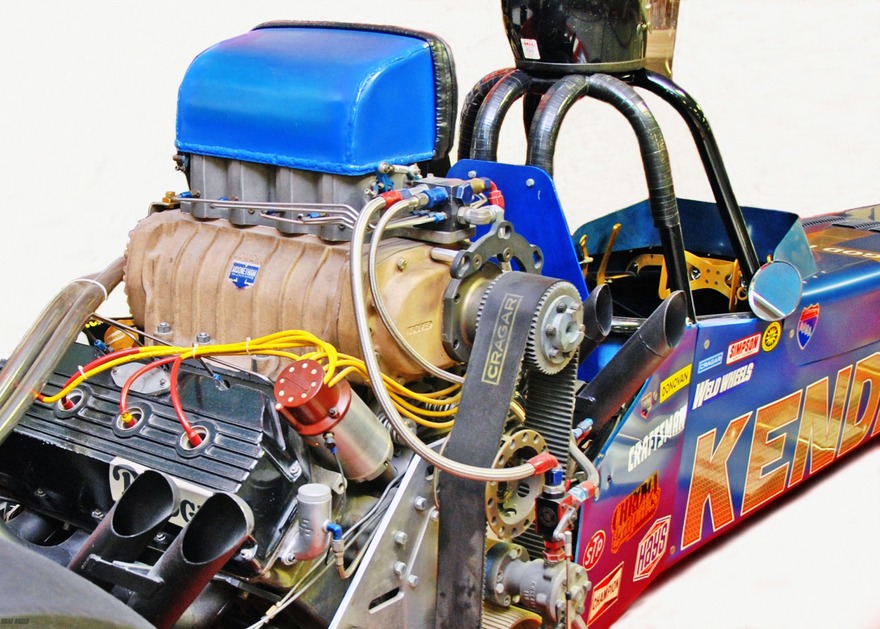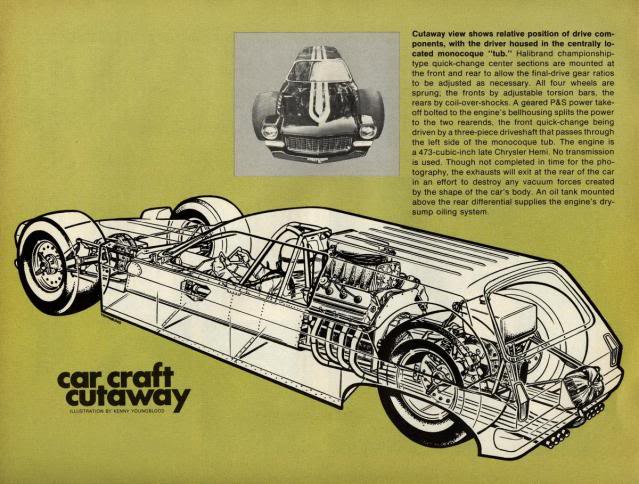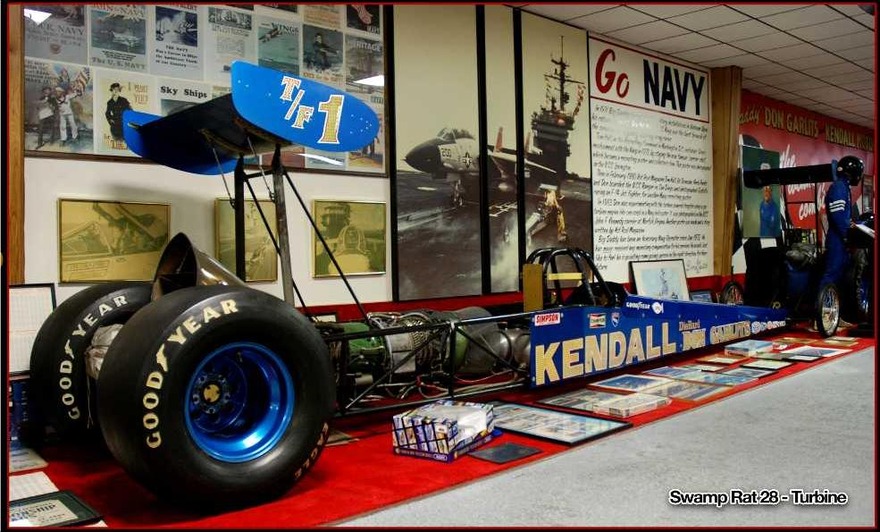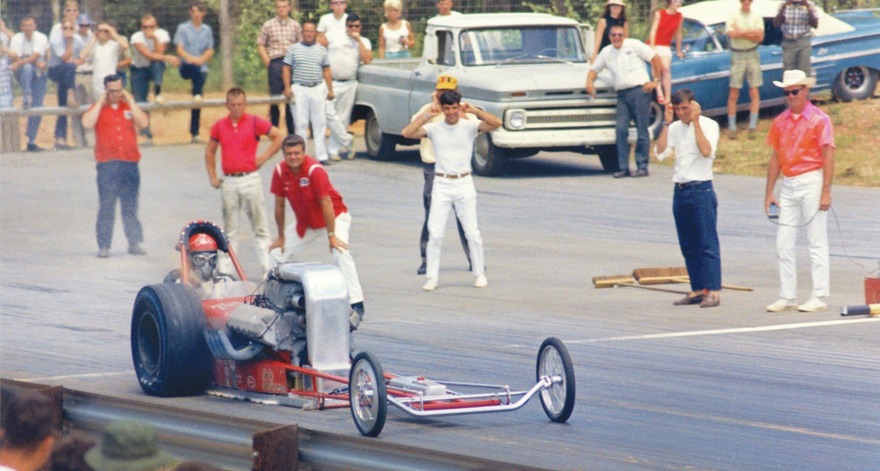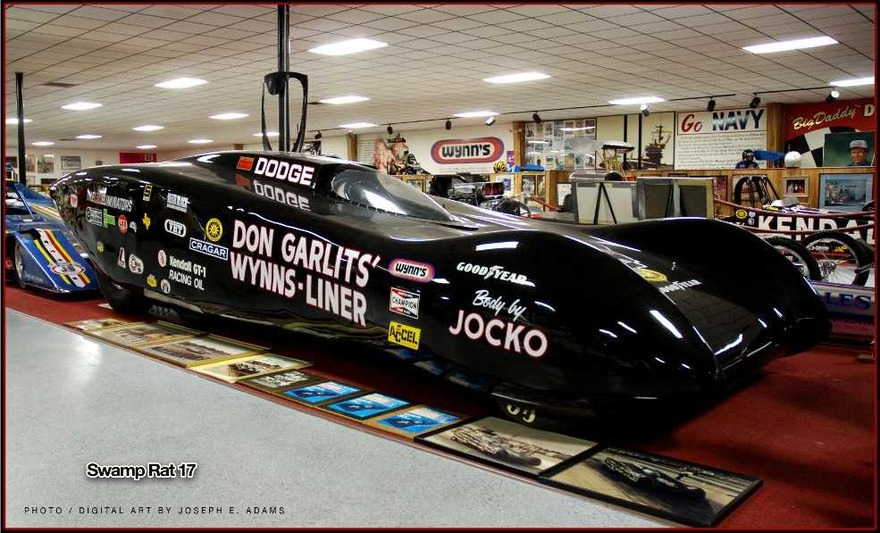These solutions were to be a real breakthrough for its time, the key to new records, and trophies. Could, but did not become...
Today's technical regulations in professional drag racing leaves little room for maneuver designers. Rulbuki (set of rules detailing the acceptable parameters of all components and assemblies dregster) so severely limit the scope for the flight of engineering that can only rely on the extremely well tuned car, teamwork, reflexes, pilot and suitable weather conditions. But it was not always.
1st attempt: Swamp Rat XXVII «Sidewinder»
Don Garlits (his name in this article we will go back again and again) throughout his career, was in a constant search for innovative solutions in the field of car design. Some of them have become the accepted standard, while others were completely unfounded and have been without any regrets thrown into the dustbin of history.
The idea of cross-engine chassis belonged to the brothers Sage and looked very attractive, because this scheme is allowed to use the moment of inertia of the motor to increase the load on the rear axle, thereby improving adhesion to the surface slicks strip.
To transfer torque to the wheels used a complex mechanism, which not only did not extremely reliable so more and eats at the same time 21% of the capacity, while in the rear axle loses only 7%.
As a result, the best result that could achieve Garlits on Swamp Rat XXVII steel 6.2 seconds at the finish. Figures unconvincing, given that the previous version of his Swamp Rat he confidently went out of six. But a series of defeats finally put an end to the project, but not in the engineering survey of the famous racer.
2nd attempt: The Funny Vega
Gary Gabelich famous mainly by the fact that in 1970 became the first person in the world who was able to exceed the speed barrier on land of 1,000 km / h, and this result remained inaccessible to other pilots for almost 13 years.
But few people know that the fastest land man of his time, not only stormed the records on the salt lakes, but with varying degrees of success in races appeared on the quarter mile, nitromethane and in both classes (Top Fuel and Funny Car). Therefore, when he first showed drawings of The Funny Vega, he did not hesitate for a second, I agreed to participate in this crazy project as a pilot and sponsor.
The Funny Vega is to this day an unprecedented dregster in every detail: four-wheel drive, mid-engine layout, monocoque aluminum space frame instead of the high-strength alloys, and it was implemented in the concept car Funny Car.
Huge V8, located behind the pilot, of course, ate wholly nitromethane because Gabelich sincerely believed that half-measures for wimps and cowards.
Price dregster creation proved a match for his radicalism, because for the majority of sites did not exist ready-made solutions.
The history of racing The Funny Vega proved equally short-lived, however the unit itself was crazy and lasted exactly one race ended a terrible accident in which the owner of the absolute speed record on land almost lost his arm.
3rd attempt: Swamp Rat XXVIII «Turbine»
Once the idea with a transverse engine fiasco, have restless Garlitsa a new plan, the essence of which he peeped in other motorsport disciplines, namely in the Tractor Pulling. Impressed by the success of the use of helicopter engines of tractors in the competition, Don built a new car, setting the chassis aviation turbine T-85, which at that time satisfied the regulations for the class AHRA Top Fuel.
The ratio of the weight of 1000 pounds and a capacity of more than 2000 hp It was to be the key to success.
However, develop the necessary motor torque to the prohibitively high speeds, making dregster completely uncompetitive on the strip, and soon the project was closed. And the public is accustomed to shaking nitromethane monsters from the stands, very cool reception to the mournful howl of the turbines.
By the way, ten years before the chief engineer, the founder and owner of the team, «Formula 1» Lotus Colin Chempenu idea with helicopter engine also seemed a good idea, but in the royal race aviation technology somehow not taken root.
4th attempt: Pete Robinson's Vacuum Cleaner
In the «Formula 1» technology is ground-effect (the creation of an air vacuum underneath the car to increase downforce), first implemented in the same Chempenom in 1977 to Lotus 78, well-proven, and brought the British stables league title in 1978.
However, a brilliant engineer and the author of many technical innovations in drag racing Pete Robinson began to think about it on the other side of the Atlantic in the late sixties. He equipped his dregster rubber curtain, preventing the ingress of air flow under the bottom, and put the baggy duct from the blower directly to the surface of the strip, so as to pump more air into the benefit of a higher dilution.
The system has proved very effective, so much car «sticks» to the track that friction Blind on the asphalt even slowed dregster.
On this issue Robinson managed using dampers to regulate the performance of his invention (in the fully closed position, the air in blower got only «from above», not from the bottom). However, another problem remained unsolved: together with the air into the engine fell dust, stones and lumps of rubber, and the installation of a filter would inevitably impact on the return of the engine.
Anyway, NHRA imposed a ban on such technical refinements immediately as soon as it became known, and the vacuum cleaner system Robinson never saw the official races.
5th attempt: Robert «Jocko» Johnson's Streamliner
Robert Johnson at the crossroads of the fifties and sixties was creating, perhaps, the most advanced scientifically race cars for races in the quarter mile.
Built they Streamliner was the fastest in 1959, breaking the barrier of 180 mph. But later the use of nitromethane for fuel on perednemotornyh dregster, whose lay-based spatial tubular frame, made his body fireballs simply uncompetitive.
Later, in 1972, Johnson suggested Don Garlittsu combine zadnemotornyh Swamp Rat XIV chassis and aerodynamic body of his own design. Thus was born the Swamp Rat XVII, which served as the basis for a shorter frame of the Top Fuel dregster and supercharged 426 Hemi running on nitromethane. Despite the fact that the estimated speed should be about 275 mph, to achieve a result in excess of 180 mph and did not work, until he Garlitts not sat behind the wheel. Shares his impressions on arrival, three-time world champion.
«After overcoming the barrier of 180 mph, the car literally start off the ground, and as soon as the rear wheel unloaded, the engine speed is increased dramatically, and I took off. As you know, after that incident, I decided to roll the project. »
Yes, not all innovations have proved their viability and even mistaken recognized guru of engineering, who throughout his career, stepped into the forefront of technological progress. Anyway, they were not afraid to go beyond the usual, by his own example to prove again and again that without trying, albeit sometimes failed, it is simply impossible to achieve positive results.

